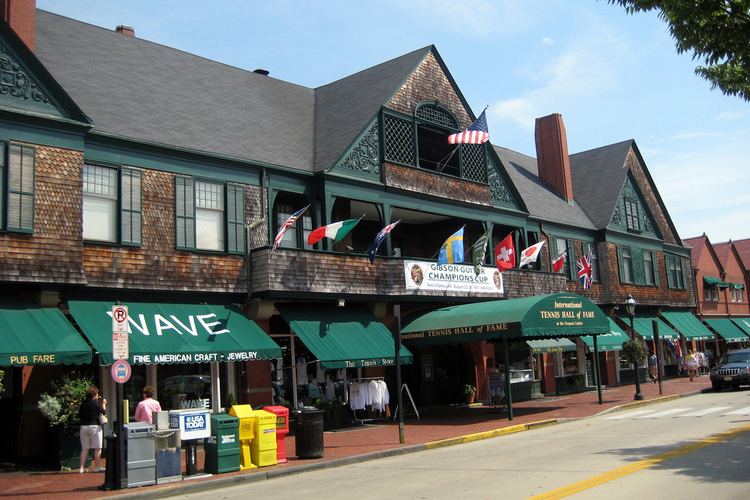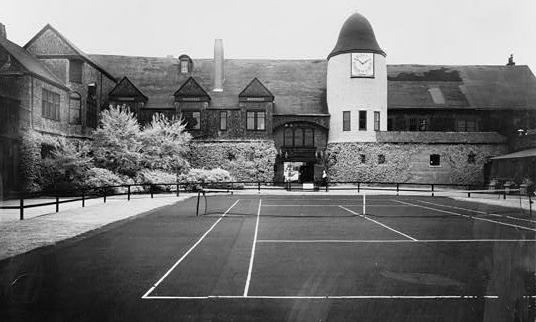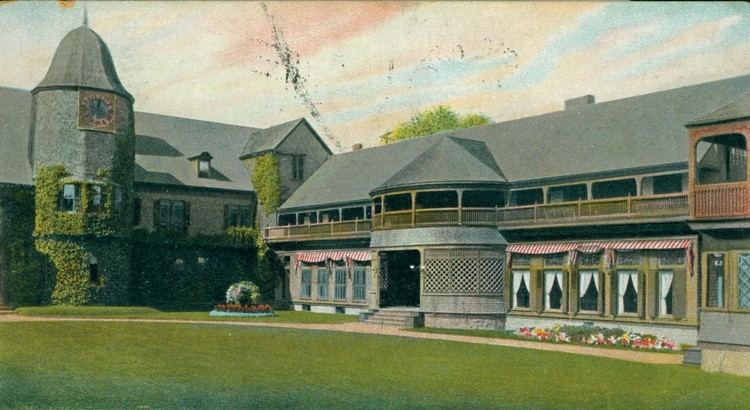NRHP Reference # 70000083 Designated NHLDCP December 8, 1972 Year built 1879 Architect McKim, Mead & White | Architectural style Shingle Style Designated NHL February 27, 1987 Area 3 ha Added to NRHP 2 December 1970 | |
 | ||
Part of Bellevue Avenue Historic DistrictBellevue Avenue/Casino Historic District (#7200002372000024) Similar International Tennis Hall of Fame, Isaac Bell House, Bellevue Avenue Historic D, Kingscote, Hunter House | ||
The Newport Casino is an athletic complex and recreation center located at 186–202 Bellevue Avenue, Newport, Rhode Island, United States. Built in 1880, it was designated a National Historic Landmark on February 27, 1987, in recognition for its architectural significance as one of the nation's finest Shingle style buildings, and for its importance in the history of tennis in the United States. The complex now houses the International Tennis Hall of Fame, and was the site of the earliest US Opens.
Contents

1879 – 1900

The complex was commissioned in 1880 by James Gordon Bennett, Jr. Legend states that Bennett placed a bet with his guest British Cavalry Officer, Captain Henry Augustus "Sugar" Candy that Candy would not ride his horse up onto the front porch of Newport's most exclusive men's club – The Newport Reading Room. Candy won the bet, but the Governors of the Reading Room were not amused. Bennett and his infamous short temper did not take this kindly, and soon set about creating his own retreat, what would eventually become The Newport Casino.

Soon after deciding to create his own social club, Bennett purchased the Sidney Brooks estate, "Stone Villa". Directly across the street was a vacant lot, suitable for construction of the Casino. Bennett hired Charles McKim (soon to be of the firm McKim, Mead, and White) to design the Casino. By January 1880, Nathan Barker of Newport was contracted to begin construction.

The interior of the Casino, while generally outlined by McKim, was entrusted to Stanford White. Taking many elements and cues from the Japanese Pavilion at the 1876 Centennial International Exhibition in Philadelphia, White provided for a plan that was both secluded and open.
The Newport Casino opened to its first patrons in July 1880, and the general public got their first view in August 1880.
1900 – 1954
The first half of the 20th century was unkind to the Newport Casino. The Gilded age drew to a close with the onset of the Depression, and the Newport fell by the wayside as a summer resort for the wealthy and powerful. The Casino struggled financially as a social club right from the start, and by the 1950s the Casino was in sad shape. Like many of the mansions, there was the very real possibility that it would be demolished to make way for more modern retail space.
The United States Lawn Tennis Association held their first championships at the Casino in 1881, an event that would continue through 1914. By this time, tennis was firmly entrenched as the key attraction at the Casino.
Candy and Jimmy Van Alen took over operating the club, and by 1954 had established the International Tennis Hall of Fame in the Newport Casino. The combination of prominent headliners at the tennis matches and the museum allowed the building to be saved.
It stands today as one of the finest examples of Victorian Shingle Style architecture in the world. The buildings are generally well preserved, and the Casino Theatre which was in a state of disrepair was recently restored and is currently leased to Salve Regina University. The theater occasionally still shows films, mostly during the Newport International Film Festival or charity events.
The landscaping in the center, new bushes were recently put in the entrance way with the old overgrown bushes removed.
Buildings
The complex includes:
Sports
The Newport Casino was never a public gambling establishment. Originally, "casino" meant a small villa built for pleasure. During the 19th century, the term casino came to include other buildings where social activities took place.
In its heyday during the Gilded Age, the Newport Casino offered a wide array of social diversions to the summer colony including archery, billiards, bowling, concerts, dancing, dining, horse shows, lawn bowling, reading, lawn tennis, tea parties, and theatricals. It was best known as the home of American lawn tennis; the Casino hosted the 1881–1914 National Championships, later called the U.S. Open. Between 1915 and 1967 it hosted the Newport Casino Invitational men's tennis tournament.
Today, there is still an active grass-court tennis club, as well as an indoor tennis club. The Newport Casino Croquet Club offers championship croquet play on Newport's grass courts.
The Court Tennis Building is part of the original complex, built in 1880. It burned down in 1945, but was rebuilt in 1980. It is home to the National Tennis Club.
